Introduction
This document describes how to work with Cisco Smart Licensing (cloud-based system) to troubleshoot and manage software licenses on Nexus switches.
What is Cisco Smart Licensing?
A Cisco Smart Account is a managed data repository that provides full visibility and access control to Cisco software licenses, entitlements and product instances across the company
New to Smart Licensing and/or Smart Account administration?
Visit and sign up for the new administrator training course and recording:
Supported Cisco Nexus Platforms
Nexus 3000 and 9000
NX-OS versions before 9.3(3) support only traditional licensing. NX-OS versions from 9.3(3) to 10.1(2) support both traditional licensing and Smart Licensing, which is covered in this document. NX-OS versions after 10.1(2) support only Smart Licensing Using Policy, which is different from Smart Licensing. For versions newer than 10.1(2), instead refer to this guide.
Nexus 7000
Smart Licensing is supported on Cisco Nexus 7000 with NX-OS 8.0(1) and newer.
Supported Methods of Smart licensing on Nexus Switches
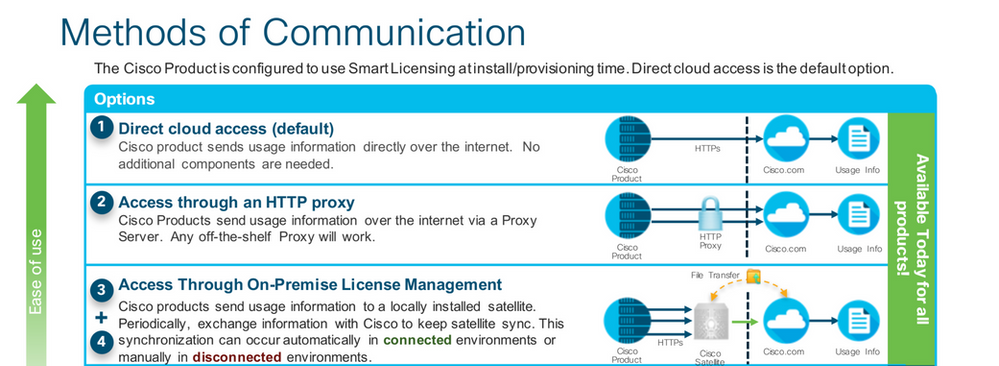
Smart Licensing User Workflow
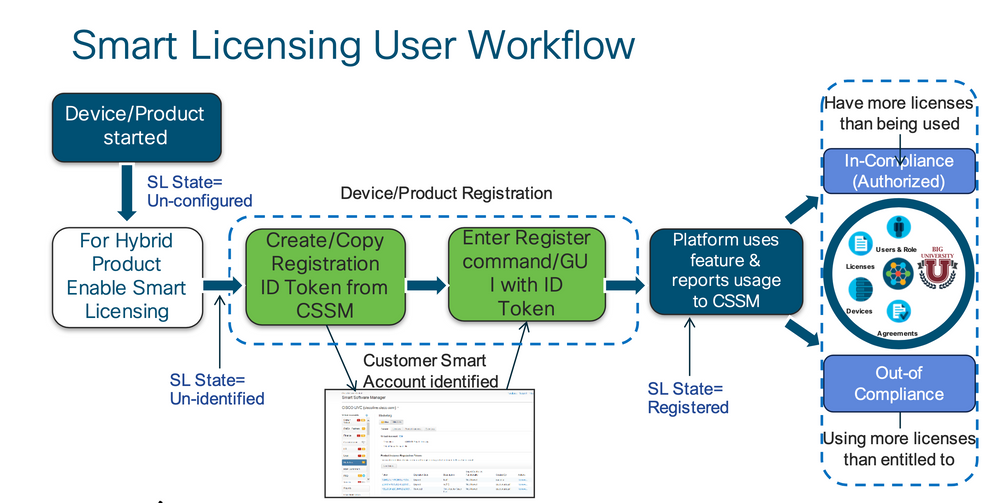
Smart License Product States
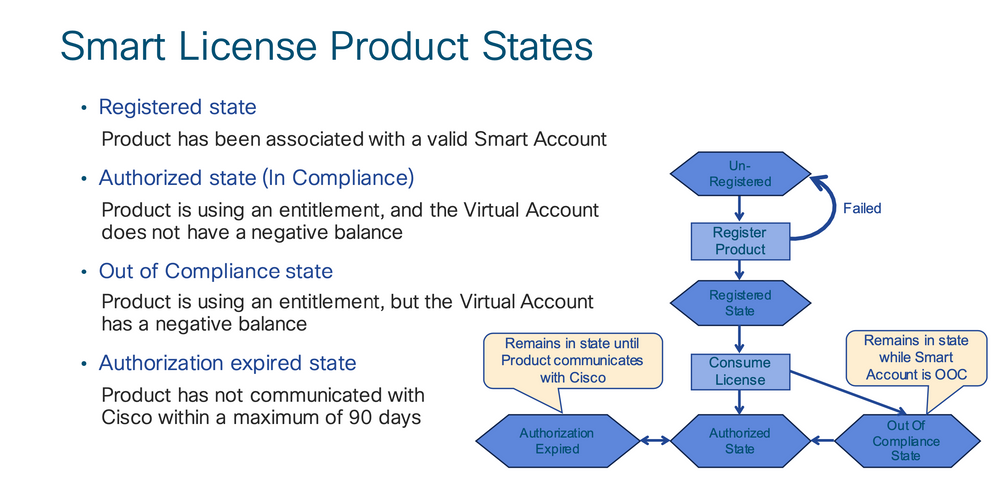
Registered
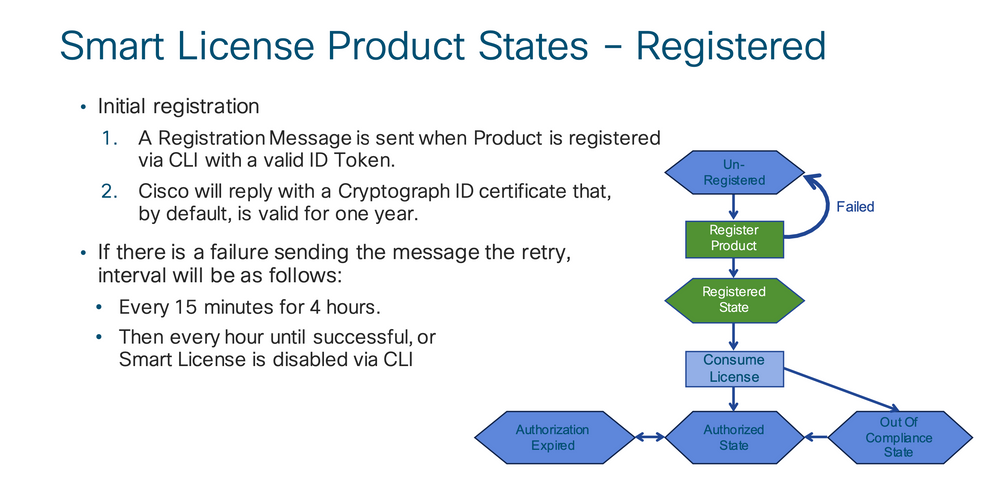
Licenses
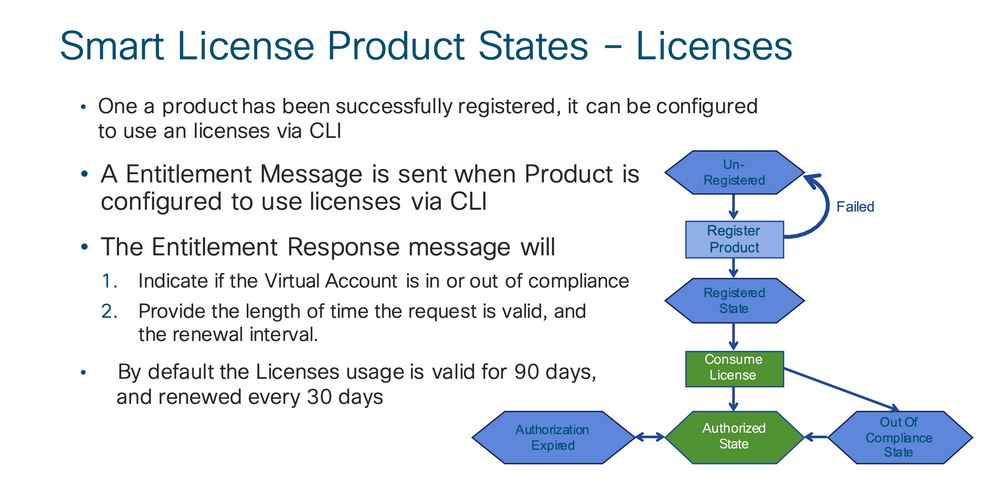
Request or Renewal
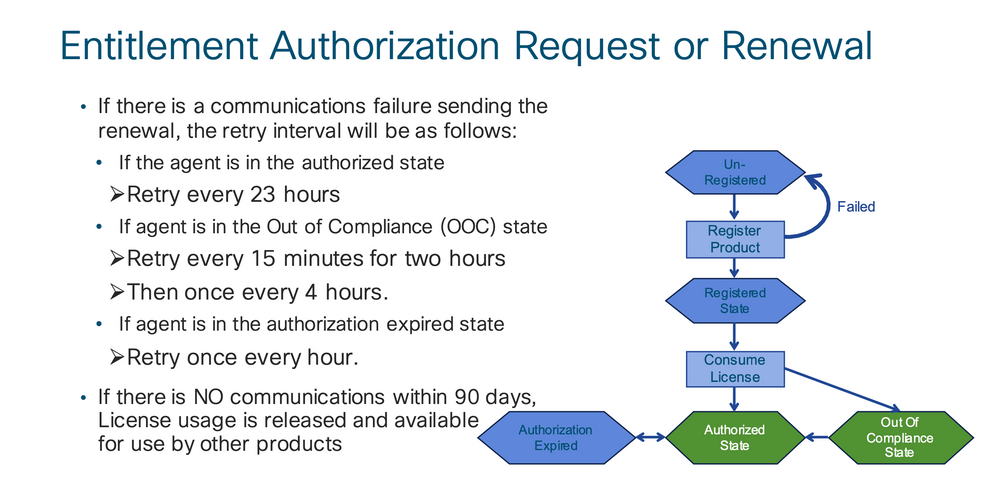
Renewal
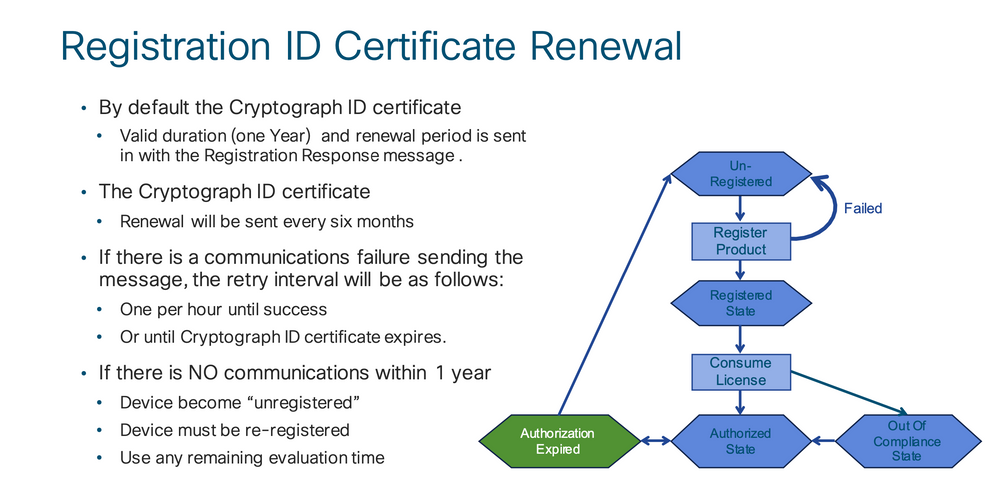
Registration and License States
While Smart Licensing is setup, there are multiple possible states that a Cisco device can be in. These states can be displayed by "show license all or show license status" from the Command Line Interface (CLI) of the Cisco device.
Here is a list of all states and their meaning:
Evaluation (Unidentified) State
- This is a default state of the device when first booted.
- Usually, this state is seen when a Cisco device has not yet been configured for Smart Licensing or registered to a Smart Account.
- In this state all features are available and the device can freely change license levels.
- The evaluation period is used when the device is in the unidentified state. The device does not attempt to communicate with Cisco in this state.
- This is be 90 days of usage and not 90 calendar days. Once it is expired it is never reset.
- There is one evaluation period for the entire device it is not per entitlement
- When the evaluation period expires at the end of 90 days, the device goes in to EVAL EXPIRY mode, however there is no functional impact or disruption in functionality, even after reload. Currently there is no enforcement in place.
- The countdown time is maintained across reboots.
- The evaluation period is used if the device has not yet registered with Cisco and has not received these two messages from the Cisco backend:
- Successful response to a registration request
- Successful response to an entitlement authorization request.
Registered State
- This is the expected state after successfully registration is complete.
- The Cisco device has been able to successfully communicate with a Cisco Smart Account and register.
- The device receives an ID certificate valid for 1 year which is used for future communications.
- The device sends a request to CSSM to authorize the entitlements for the licenses in use on the device.
- Based on the CSSM response the device then enters Authorized or Out-of-Compliance
- The Id certificate expires at the end of one year. After 6 months the software Agent process tries to renew the certificate. If the Agent cannot communicate with the Cisco Smart Software Manager it continues to try and renew the Id certificate until the expiration date (1 year). At the end of one year, the agent goes back to the Unidentified state and tries to enable the Evaluation period. The CSSM removes remove the product instance from its database.
Authorized State
- This is the expected state when device uses an entitlement and is in Compliance (no negative balance),
- The Virtual Account on CSSM had the correct type and number of licenses to authorize the consumption of the device licenses.
- At the end of 30 days, the device sends a new request to CSSM to renew the authorization.
- Has a time span of 90 days after which (if not successfully renewed) is moved to Authorization Expired state.
Out-of-Compliance State
- This is the state when device uses an entitlement and is not in Compliance (negative balance).
- This state is seen when the device does not have an available license in the corresponding Virtual Account that the Cisco device is registered to in the Cisco Smart Account.
- To enter into Compliance / Authorized state, you must add the correct number and type of licenses to the Smart Account.
- When in this state the device automatically sends an authorization renewal request every day.
- Licenses and features continue to operate and there is no functional impact.
Authorization Expired State
- This is the state when device uses an entitlement has not been able to communicate with the Cisco Smart Account associated for over 90 days.
- This is typically seen if the Cisco device loses internet access or cannot connect to tools.cisco.com after initial registration.
- Online methods of smart licensing require Cisco devices to communicate a minimum of every 90 days to prevent this status.
- CSSM returns all in use licenses for this device back to the pool since it has not had any communications for 90 days.
- While in this state the device continues to try to contact Cisco, every hour, to renew the entitlement authorization, until the registration period (id certificate) expires.
- Licenses and features continue to operate and there is no functional impact.
- If the software Agent re-establishes communications with Cisco and receives to its request for authorization it processes that reply normally and enter into one of the established states.
Supported Methods on Nexus and config
Method-1 (Direct Cloud Access )
Basic configuration:
switch# show run callhome
!Command: show running-config callhome
!Running configuration last done at: Wed Jun 22 16:14:37 2022
!Time: Wed Jun 22 16:16:28 2022
version 9.3(4) Bios:version 07.67
callhome
email-contact sch-smart-licensing@cisco.com
destination-profile CiscoTAC-1 transport-method http
destination-profile CiscoTAC-1 index 1 http https://tools.cisco.com/its/service/oddce/services/DDCEService
transport http use-vrf management
enable
Switch# license smart register idtoken XXXX (force)
Initiated device registration with backend. run show license status, for registration status
switch# show license status
Smart Licensing is ENABLED
Registration:
Status: REGISTERED
Smart Account: ldap_user_test
Virtual Account: Default
Export-Controlled Functionality: Allowed
Initial Registration: SUCCEEDED on Jun 22 16:15:41 2022 UTC
Last Renewal Attempt: None
Next Renewal Attempt: Dec 19 16:15:41 2022 UTC
Registration Expires: Jun 22 16:13:53 2023 UTC
License Authorization:
Status: AUTHORIZED on Jun 22 16:15:44 2022 UTC
Last Communication Attempt: SUCCEEDED on Jun 22 16:15:44 2022 UTC
Next Communication Attempt: Jul 22 16:15:43 2022 UTC
Communication Deadline: Sep 20 16:12:55 2022 UTC
Smart License Conversion:
Automatic Conversion Enabled: False
Status: Not started
https://www.cisco.com/c/en/us/td/docs/switches/datacenter/sw/nx-os/licensing/guide/b_Cisco_NX-OS_Licensing_Guide/m-smart-licensing-for-cisco-nexus-3000-and-9000-series-switches.html
Method-2 (Access through an HTTP Proxy)
switch# show run callhome
version 9.3(4) Bios:version 07.67
call home
email-contact sch-smart-licensing@cisco.com<mailto:sch-smart-licensing@cisco.com>
destination-profile CiscoTAC-1 transport-method http
destination-profile CiscoTAC-1 index 1 http https://tools.cisco.com/its/service/oddce/services/DDCEService
transport http proxy server X.X.X.X port 80
transport http use-vrf management
transport http proxy enable
Switch# license smart register idtoken XXXX (force)
Initiated device registration with backend. run show license status, for registration status
Method-3 (On-Prem – Online )
switch# show run callhome
version 9.3(4) Bios:version 07.67
callhome
email-contact sch-smart-licensing@cisco.com
destination-profile CiscoTAC-1 transport-method http
destination-profile CiscoTAC-1 index 1 http https://10.106.41.xx/Transportgateway/services/DeviceRequestHandlerend
transport http use-vrf management
enable
Switch# license smart register idtoken XXXX (force)
Initiated device registration with backend. run show license status, for registration status
Method-4 (On-Prem – Offline )
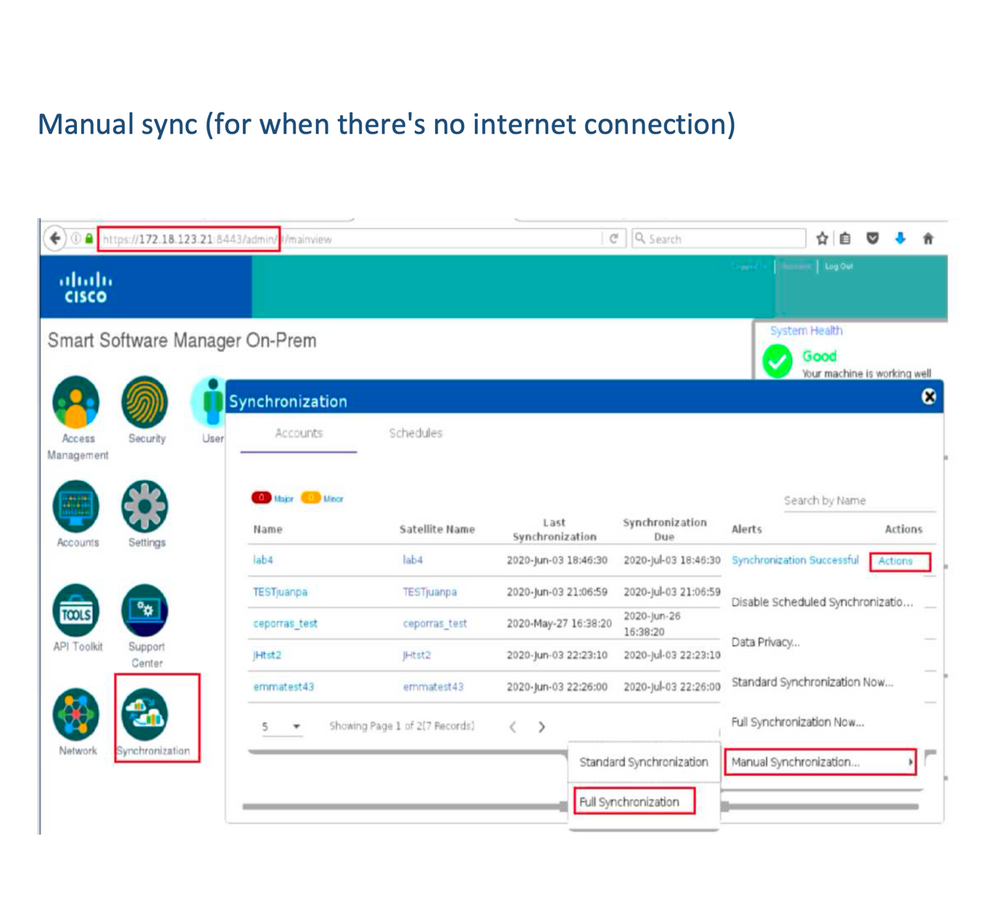
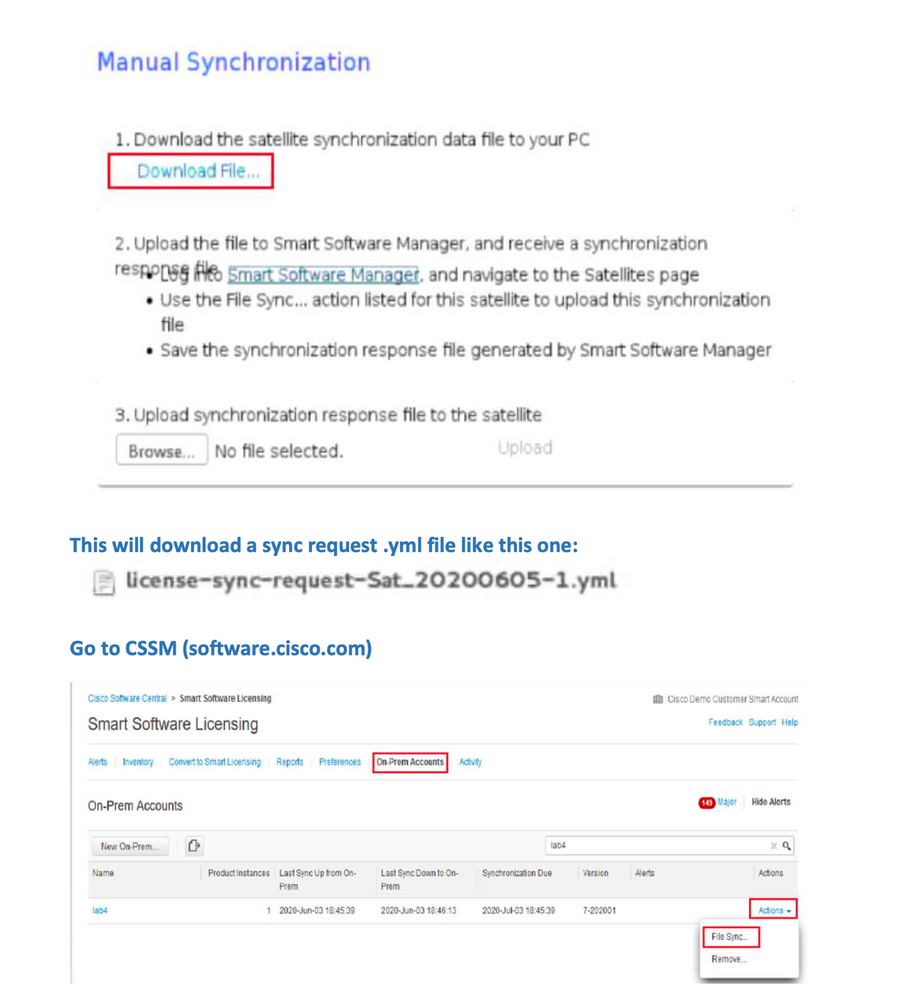
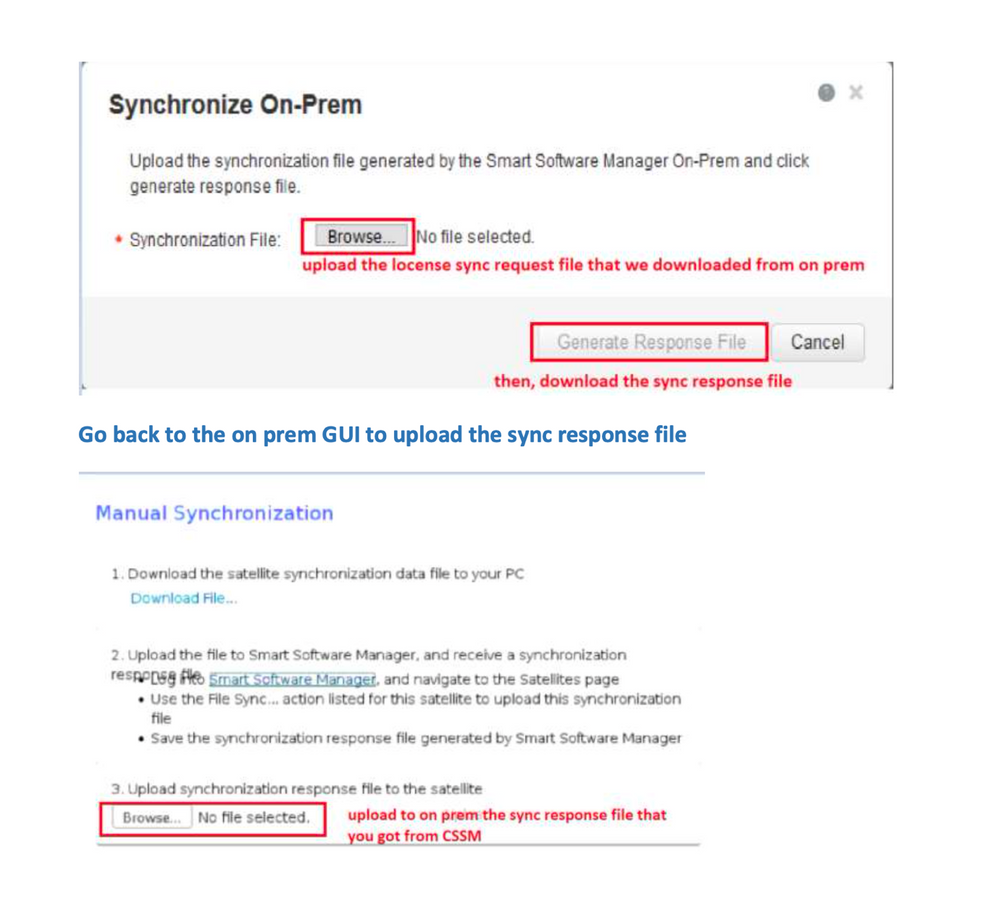
What is ID Token?
Used to securely Register products to a Smart Account and Virtual Account
ID Tokens are organizational identifier used to establish identity when a product is registered.
How to Generate ID Token from CSSM
https://software.cisco.com/software/csws/ws/platform/home?locale=en_US#
Manage licenses -> Inventory -> General -> New token -> Create token
Troubleshoot
When a Cisco device is migrated to a Smart Licensing enabled software version, this flowchart can be used as a general guide for all three methods (Direct Cloud Access, HTTPS Proxy, and Cisco Smart Software Manager On-prem).
Workflow
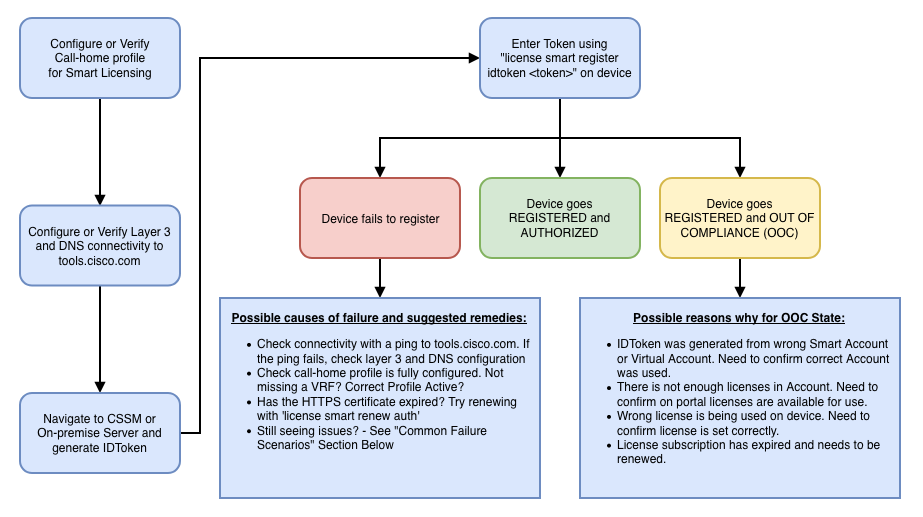
Known Issues
- The issue to get N9K-C9348GC-FXP registered for smart licensing.
1. Error -Fail to Send Out Call Home HTTP
[+] Call home configs
Switch# show running-config callhome
version 9.3(5) Bios:version 07.68
callhome
email-contact abc@example.com
phone-contact +919XXXXXXXXX
streetaddress ST3, RD 4, Bangalore
destination-profile CiscoTAC-1 transport-method http
destination-profile CiscoTAC-1 index 1 http http://tools.cisco.com/its/service/oddce/services/DDCEService
transport http use-vrf management
[+] Confirmed reachablility to tools.cisco.com.
DC-DMZ(config)# ping tools.cisco.com vrf management
PING tools.cisco.com (72.163.4.38): 56 data bytes
64 bytes from 72.163.4.38: icmp_seq=0 ttl=232 time=237.581 ms
64 bytes from 72.163.4.38: icmp_seq=1 ttl=232 time=237.859 ms
64 bytes from 72.163.4.38: icmp_seq=2 ttl=232 time=237.562 ms
64 bytes from 72.163.4.38: icmp_seq=3 ttl=232 time=237.413 ms
64 bytes from 72.163.4.38: icmp_seq=4 ttl=232 time=237.995 ms
DC-DMZ(config)# telnet tools.cisco.com 443 vrf management
Trying 2001:420:1101:5::a...
Trying 72.163.4.38...
Connected to tools.cisco.com.
Escape character is '^]'.
^CConnection closed by foreign host.
+ HTTP source interface was configured to interface vlan 27, Changed it to mgmt0
2. Error -Fail to Parse Response Data from SCH Server
++ HTTP is no longer supported to reach backend of Cisco; HTTPS is only supported. Removed current configuration and updated the destination address to use HTTPS.
Previous config
destination-profile CiscoTAC-1 transport-method http
destination-profile CiscoTAC-1 index 1 http http://tools.cisco.com/its/service/oddce/services/DDCEService
transport http use-vrf management
enable
New config added
(config)#callhome
(config-callhome)#enable
(config-callhome)# destination-profile CiscoTAC-1 transport-method http
(config-callhome no destination-profile CiscoTAC-1 index 1 http http://tools.cisco.com/its/service/oddce/services/DDCEService
(config-callhome destination-profile CiscoTAC-1 http https://tools.cisco.com/its/service/oddce/services/DDCEService
3. Error - Fail to Send Out Call Home HTTP Message (Fails to Establish IPC Connect with Call Home – Quo Vadis Root CA)
https://www.cisco.com/c/en/us/support/docs/field-notices/721/fn72115.html
4. Error - Lack of DNS Response Causes Callhome MTS Messages Stuck
Cisco Bug ID CSCvv67469












 Feedback
Feedback